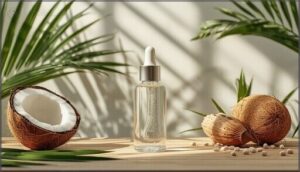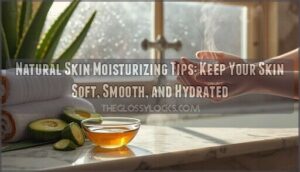This site is supported by our readers. We may earn a commission, at no cost to you, if you purchase through links.
You’re carefully reading ingredient labels on your favorite moisturizer when you spot “glycerin” listed third. It’s a staple in everything from hand creams to cough syrups, but here’s the catch: glycerin can come from plants, animals, or petroleum—and most labels won’t tell you which.
For anyone committed to a vegan lifestyle, this ambiguity creates a real problem. You can’t simply avoid glycerin either, since it’s one of the most effective humectants available, pulling moisture into your skin and keeping it there for days.
The good news is that vegan glycerin exists and performs identically to its animal-derived counterpart, but identifying it requires knowing what certifications to look for and which questions to ask manufacturers.
Table Of Contents
Key Takeaways
- Glycerin can come from plants, animals, or petroleum, and most product labels won’t specify which source was used, making verification essential for vegans through third-party certifications like Vegan Action Certified or the Vegan Trademark.
- Plant-based glycerin performs identically to animal-derived versions in skincare and other applications, offering the same moisture-locking properties without ethical compromises while dominating the global market at roughly 48-55% of production.
- You can identify vegan glycerin by looking for specific certifications on labels, checking for “vegetable glycerin” designations, or directly contacting manufacturers who maintain documentation about ingredient sourcing.
- Vegan alternatives to glycerin include coconut oil, jojoba oil, and castor oil, which provide comparable moisturizing benefits through plant-based sources with sustainable production methods.
What is Glycerin?
Glycerin is one of those ingredients that shows up everywhere—from your moisturizer to your toothpaste to your favorite snack bar—but most people don’t give it much thought.
It’s a simple compound with some pretty useful properties, and understanding what it actually is matters when you’re trying to figure out whether it fits your lifestyle.
Let’s break down the basics of glycerin so you know exactly what you’re working with.
Chemical Properties of Glycerin
Fundamentally, glycerin is a three-carbon compound with the molecular formula C₃H₈O₃, featuring three hydroxyl groups that give it notable properties. This sugar alcohol boasts impressive solubility in water and polar solvents, making it highly adaptable. Its hygroscopicity—the ability to absorb moisture—combined with relatively high viscosity and thermal stability, explains why it’s such a valued humectant. The compound resists degradation under normal storage conditions, though it requires careful handling away from strong oxidizers. According to its safety data sheet, glycerin causes irritation to the skin and eyes.
Key chemical characteristics:
- Molar mass of 92.09 g/mol with stable, non-aromatic structure
- High viscosity (~1.5 Pa·s) supporting formulation consistency
- Excellent water miscibility enabling homogeneous mixtures
- Chemical stability under standard atmospheric pressure and temperature
Common Uses in Everyday Products
Glycerin is a ubiquitous ingredient, appearing in a wide range of products across various industries. In cosmetics and personal care, it’s the third most-used ingredient globally, found in over 23,000 products. From skincare and lotions to toothpaste and shaving cream, glycerin acts as a humectant and emollient, keeping skin moisturized and products from drying out.
In the food industry, glycerin serves as a sweetener, preservative, and texture modifier, enhancing the taste and shelf life of processed foods and beverages. Pharmacists rely on glycerin for its versatility, using it in cough syrups, ointments, and suppositories as a solvent and palatability enhancer. Even in industrial applications, glycerin’s unique properties make it an essential component in coatings, textiles, and antifreeze, functioning as a plasticizer and viscosity modifier. As a result, it’s often used in skincare and lotions for hydration.
| Category | Product Examples | Primary Function |
|---|---|---|
| Cosmetics & Personal Care | Toothpaste, shaving cream, moisturizers | Humectant, emollient |
| Food Products | Sweeteners, processed foods, beverages | Sweetener, preservative, texture modifier |
| Pharmaceuticals | Cough syrups, ointments, suppositories | Solvent, palatability enhancer |
| Industrial & Household | Coatings, textiles, antifreeze | Plasticizer, viscosity modifier |
Hygroscopic and Moisturizing Qualities
What makes glycerin notable is its hygroscopic nature—it actively pulls moisture from the air into your skin. This isn’t passive moisturizing; glycerin’s three hydroxyl groups form hydrogen bonds with water molecules, creating a moisture-locking effect that persists for days. Clinical studies confirm that even 10% glycerin solutions reduce transepidermal water loss (TEWL) to levels matching healthy, untreated skin. At higher concentrations, glycerin’s humectant efficacy outperforms common alternatives like propylene glycol, delivering sustained skin hydration across varying humidity levels.
Glycerin’s hygroscopic nature actively pulls moisture from air into skin, creating a multi-day moisture-locking effect that outperforms common alternatives
- Hygroscopicity rapidly reduces relative humidity from 70% to 20% within seconds
- Water retention capacity increases proportionally with glycerin concentration up to 60%
- Barrier function improves through stabilized emulsions and reinforced skin moisture barriers
- TEWL reduction achieves healthy skin equivalence at clinical concentrations
- Humectant efficacy aids aquaporins for deep, sustained hydration.
How is Glycerin Sourced and Produced?
Glycerin doesn’t just appear in your skincare routine or food pantry—it has to come from somewhere. The source matters, especially if you’re trying to figure out whether a product fits your values.
Let’s look at where glycerin actually comes from and how it gets made.
Plant-Based Glycerin Production
Where does plant-based glycerin come from, and how do manufacturers extract it? Most production starts with vegetable oil feedstocks—primarily palm, coconut, and soy oils—which undergo transesterification or steam hydrolysis to yield crude glycerin. This refined product then undergoes multistage purification to meet pharmaceutical and cosmetic standards.
| Production Method | Oil Feedstock | Purity Output | Sustainability |
|---|---|---|---|
| Transesterification | Palm, Coconut, Soy | 99%+ | Biodiesel byproduct |
| Steam Hydrolysis | Vegetable oils | 99%+ | Energy-intensive |
| Fermentation | Plant starches | 95-98% | Low impact |
| High-pressure hydrolysis | Mixed oils | 99%+ | Efficient |
Industry trends show Asia-Pacific dominates production at 45.3% market share, with manufacturers increasingly sourcing from waste oils to reduce environmental footprints while meeting vegan glycerin demand.
Animal-Derived Glycerin Methods
When manufacturers process animal fats like tallow and lard, they use high-pressure hydrolysis to break down triglycerides into glycerin-rich solutions exceeding 30% concentration. This fat hydrolysis yields a biodiesel byproduct that undergoes multi-stage refining through neutralization and vacuum distillation. Though animal-derived glycerin represents only about 9% of global market share, it remains prevalent in regions with established livestock industries. The refining processes remove fatty acids and impurities, producing glycerin suitable for cosmetics and pharmaceuticals.
Key production characteristics:
- High-pressure hydrolysis operates at 600 PSI with elevated temperatures
- Biodiesel byproduct yields approximately 100 kg glycerin per ton
- Vacuum distillation removes residual water, salts, and contaminants
- Animal-sourced glycerin appears in livestock feed formulations up to 15%
- Neutralization and de-esterification guarantee pharmaceutical-grade purity
Synthetic Glycerin Origins
When petrochemical feedstocks like propylene undergo chlorination, they become the foundation for synthetic glycerin production through the epichlorohydrin process. This route accounts for roughly 10% of global glycerin output, with conversion yields reaching 90% in optimized systems. Major chemical companies operate industrial-scale plants, particularly in Asia-Pacific regions.
Synthetic glycerin finds use in pharmaceutical, cosmetic, and food applications where high purity—often exceeding 99.7%—is essential. Modern synthesis advancements now incorporate bio-based alternatives, shifting the industry toward more sustainable production methods while maintaining regulatory compliance.
Is Glycerin Vegan?
The answer to whether glycerin is vegan depends entirely on where it comes from. Animal-derived glycerin clearly isn’t vegan, but plant-based and synthetic versions can be—though the distinction isn’t always obvious from a product label.
Here’s what actually determines whether glycerin fits your vegan lifestyle.
Criteria for Vegan Ingredients
What makes an ingredient truly vegan? It’s not just about the starting material—it’s about eliminating animal involvement at every step. Vegan ingredient criteria demand a complete absence of animal-derived substances, testing, and processing aids throughout the supply chain. Here’s what vegan certifications verify:
- No animal-derived additives like gelatin, lanolin, or tallow in formulations
- Supply chain audits confirming plant or synthetic origins only
- Cross-contamination risk prevention during manufacturing
- Third-party documentation proving animal-free processing methods
These rigorous standards make certain your ingredients align with your values.
Animal Vs. Plant-Based Sourcing
Here’s where the sourcing split gets real: animal-derived glycerin comes from rendering tallow and other fats in the meat industry, while plant-based varieties originate from vegetable oils like soy, palm, and coconut. The difference matters. Plant-based options now dominate the market, accounting for the majority of global production due to renewable feedstocks and lower environmental impact. Animal-derived glycerin remains a niche industrial choice, primarily for specific pharmaceutical applications rather than consumer products.
| Aspect | Animal-Derived | Plant-Based |
|---|---|---|
| Source | Tallow, lard from meat processing | Soy, palm, coconut oils |
| Market Share | Minority, niche industrial use | Dominant, expanding globally |
| Production Method | Fat rendering and hydrolysis | Oil hydrolysis and purification |
| Environmental Impact | Higher carbon footprint | Lower emissions, renewable |
Synthetic Glycerin and Vegan Status
Here’s where synthetic glycerin enters the picture: it’s produced from petrochemical origins like propylene, making it completely animal-free. This matters for vegan status because synthetic glycerin contains zero animal inputs throughout production. What clinches its vegan credentials?
- Petrochemical feedstocks eliminate animal involvement entirely
- Vegan certification requires verification of non-animal processing aids
- Industrial applications across cosmetics and pharmaceuticals mandate rigorous labeling regulations
Most synthetic glycerin marketed today carries vegan certification when produced to standards and tested below contamination thresholds.
How to Identify Vegan Glycerin
Finding vegan glycerin isn’t as tricky as it might seem—you just need to know what to look for on labels and packaging. The good news is that manufacturers and third-party certifiers have made it pretty straightforward to verify whether the glycerin in your products comes from plants or animals.
Here’s how to do the detective work yourself.
Certifications and Trademarks to Look For
When you’re hunting for truly vegan glycerin, third-party certifications are your most reliable compass. Look for the Vegan Action Certified logo, which appears on over 10,000 products and explicitly prohibits animal-derived ingredients. The Vegan Trademark, trusted by 65,000+ products worldwide, offers similar assurance. PETA’s Cruelty-Free mark confirms no animal testing occurred.
In Europe, “vegetable glycerin” labeling combined with EU E422 designation signals plant origin. Halal indicators also suggest plant-based sources, since porcine glycerin is prohibited.
These vegan certification logos work together—they’re your verification system that what you’re buying aligns with your values.
Contacting Manufacturers for Source Verification
But what if a product lacks clear labeling? You can reach out directly to manufacturers—they’re equipped to answer. Most maintain supplier documentation and technical data sheets specifying whether glycerin comes from vegetable oils, animal fats, or synthesis.
A straightforward email asking about ingredient sourcing generally gets results. Manufacturers increasingly recognize that transparent disclosure about glycerin’s origin builds trust and keeps customers coming back.
Why Choose Vegan Glycerin?
Choosing vegan glycerin isn’t just about aligning with your values—it comes with real practical benefits too. Whether you’re concerned about the ethics behind your skincare, worried about potential allergens, or committed to living fully vegan, there are solid reasons to make the switch.
Let’s look at what makes vegan glycerin worth seeking out.
Ethical and Environmental Considerations
When you choose vegan glycerin, you’re supporting ethical labor practices and reducing environmental harm. Plant-based options carry a substantially lower carbon footprint than synthetic or animal-derived alternatives, especially biodiesel-derived glycerin, which operates as a sustainable byproduct.
However, deforestation and habitat destruction remain concerns with palm-sourced glycerin. Seek RSPO-certified or organic soy-based products to confirm your choice backs responsible sourcing and minimizes deforestation impact while advancing sustainable advances in the industry.
Allergen and Safety Factors
Beyond environmental impact, plant-based glycerin offers genuine safety advantages. Regulatory status confirms its nontoxic profile—the FDA recognizes it as safe for topical and oral use. Allergy prevalence remains remarkably low; clinical studies show glycerin causes reactions in less than 1% of users, making it ideal for sensitive skin.
The real concern isn’t glycerin itself but contamination risks from impurities like diethylene glycol. Choosing certified plant-based options ensures rigorous testing and ingredient purity, protecting your health while aligning with your values.
Suitability for Vegan Lifestyles
For those committed to a vegan lifestyle, plant-based glycerin removes the guesswork. You’re no longer wondering if your skincare or supplements contain animal byproducts.
Certified vegan glycerin guarantees your ingredients align with your values—no tallow, no lard, no animal-derived compromise.
When you choose products with verified plant-based glycerin and proper certifications, you’re supporting ethical sourcing and transparent manufacturing. It’s freedom from uncertainty.
Glycerin in Food and Personal Care Products
You’ll find glycerin in far more places than you might realize—from the moisturizer on your bathroom shelf to the gummy vitamins in your kitchen cabinet.
Whether it’s keeping your skin hydrated, sweetening your food, or serving as a key ingredient in medications, glycerin plays different roles depending on where it shows up.
Let’s look at how this adaptable compound functions across these three major categories.
Glycerin in Skincare and Cosmetics
When you apply a moisturizer with glycerin, you’re harnessing one of skincare’s most reliable humectants—a powerhouse ingredient that draws moisture deep into your skin. Glycerin ranks as the third most common cosmetic ingredient, appearing in over 15,600 products across foundations, serums, and creams. Its versatility shines through:
- Formulations with 25–40% glycerin create sustained hydration lasting up to 24 hours
- Clinical studies show 20% reduction in water loss and improved barrier function
- Vegan formulations deliver identical moisturizing benefits without animal-derived sources
Your choice of vegan glycerin-based skincare delivers professional results with ethical alignment.
Use of Glycerin in Food Items
Glycerin appears in nearly 38% of bakery and confectionery products, where it acts as a humectant that locks in moisture and extends shelf life. You’ll also find it stabilizing functional beverages, enhancing processed dairy, and improving texture in grain-based foods.
Food additives like glycerin serve multiple roles—preventing staleness, supporting low-calorie formulations, and blending ingredients seamlessly.
When selecting food products, check labels for “vegetable glycerin” or “plant-based glycerin” to verify your vegan labeling aligns with your values, as some food preservation methods still rely on animal-derived sources.
Role in Pharmaceuticals and Supplements
In pharmaceutical formulations and supplements, you’ll encounter glycerin serving multiple critical roles. The pharmaceutical glycerin market is experiencing impressive growth—projected to reach $246.48 million by 2030 with an 11% annual increase. Here’s what makes it essential:
- Solvent in cough syrups and expectorants
- Humectant maintaining moisture in topical formulations
- Osmotic diuretic for managing cerebral edema
- Stabilizer in capsules and tablets
- Performance enhancer in athletic supplements
Pharmaceutical-grade purity standards demand aldehyde content below 5 ppm, ensuring safety for sensitive applications.
When selecting supplements, verify “vegetable glycerin” or “plant-based glycerin” on ingredient labels to align with vegan preferences while maintaining therapeutic efficacy and dosage considerations.
Vegan Alternatives to Glycerin
If you’re looking to swap out glycerin but want to keep those same moisturizing and stabilizing benefits, you’ve got solid options available.
Plant-based alternatives can work just as well in your skincare and personal care routine, depending on what you’re trying to achieve.
Here’s what actually performs well as a glycerin substitute.
Plant-Based Waxes
Plant-based waxes offer a compelling alternative to glycerin for those committed to vegan formulations. Derived from renewable sources like carnauba, candelilla, and sunflower oils, these sustainable waxes provide biodegradable materials perfect for natural cosmetics and eco-friendly packaging.
The global plant-based wax market is projected to reach $4.5 billion by 2033, driven by consumer demand for vegan candles and environmentally conscious products.
Unlike animal-derived glycerin, plant-based waxes align seamlessly with your values while delivering reliable performance across skincare and home goods.
Castor Oil
If you’re seeking a plant-based alternative to glycerin, castor oil stands out as a renewable resource that won’t compromise your vegan principles. Derived from castor beans through cold-pressing or solvent extraction, this biodegradable oil delivers powerful moisturizing benefits in skincare and pharmaceuticals.
Its sustainable production methods support rural farmers while reducing dependence on petrochemicals. Castor oil’s versatility makes it an excellent choice for formulators committed to plant-based, ethical cosmetics without sacrificing performance.
Coconut Oil
Coconut oil emerges as a powerhouse plant-based alternative that mirrors glycerin’s moisturizing prowess without ethical compromises. Extracted from coconut kernels through mechanical or solvent methods, this vegan staple delivers hydrating benefits across skincare and food applications.
What makes coconut oil compelling:
- Cold-pressed varieties preserve nutrient density and antioxidant properties
- Medium-chain triglycerides enable rapid skin absorption and energy release
- Sustainable production methods support tropical farming communities
- Adaptable across cosmetics, culinary uses, and pharmaceutical formulations
- Naturally antimicrobial lauric acid content promotes skin health
Jojoba Oil
If you’re looking for glycerin’s closest competitor, jojoba oil delivers comparable hydration through a completely different mechanism. This liquid wax ester—comprising roughly half the jojoba seed’s weight—mimics your skin’s natural oils remarkably well, forming a protective barrier that locks in moisture without the sourcing ambiguity of glycerin.
Cold-pressed varieties dominate the market, reflecting consumer preference for minimally processed plant oils. Jojoba thrives in arid climates with minimal water, making sustainable production straightforward.
Its non-comedogenic profile suits even acne-prone skin, offering vegan moisturizing power without compromise.
Frequently Asked Questions (FAQs)
Can glycerin cause skin reactions or allergies?
Like ancient alchemists discovering elixirs, modern scientists have confirmed glycerin’s impressive safety record. True allergic reactions are exceptionally rare—documented in only four published case reports—though mild skin irritation occasionally occurs with concentrated formulations.
How is crude glycerin refined for cosmetics?
Crude glycerin undergoes filtration methods, distillation processes, bleaching techniques, and ion exchange purification steps to remove impurities.
These refining stages transform biodiesel or saponification by-products into cosmetic-grade vegetable glycerin suitable for skincare formulations.
Does glycerin expire or lose effectiveness over time?
Time isn’t always kind to this humectant. Pure glycerin usually lasts 24 months when stored below 100°F in sealed containers.
Exposure to heat, light, or air accelerates degradation, reducing its moisture retention and skin health benefits over time.
Is glycerin production regulated by environmental standards?
Yes, glycerin production falls under environmental regulations governing emissions, waste management, and sustainable sourcing. Facilities must comply with standards like the Clean Air Act and ISO 14001 to minimize their environmental impact.
What percentage of global glycerin is vegan-sourced?
Roughly 48-55% of global glycerin comes from plant-based, vegan-friendly sources. Regional production varies widely—Asia-Pacific leads at 48% market share, with certification impact and consumer demand driving steady growth toward sustainable, vegan glycerin sources.
Conclusion
Picture yourself standing in the pharmacy aisle, confidently choosing a cough syrup because you’ve spotted the certified vegan seal on its label. That’s the clarity you gain from understanding glycerin’s origins. When you know which certifications matter and which questions to ask manufacturers, determining if glycerin is vegan becomes straightforward rather than guesswork.
Your skincare routine, medications, and food choices can align perfectly with your values—no compromises necessary.
- https://elchemy.com/blogs/chemical-market/choosing-between-glycerin-and-vegetable-glycerin-for-personal-care-formulations
- https://wiser.eco/is-glycerin-vegan/
- https://www.crueltyfreekitty.com/cruelty-free-101/is-glycerin-vegan/
- https://market.us/report/global-glycerine-market/
- https://www.veganverify.com/blog/is-glycerin-vegan











